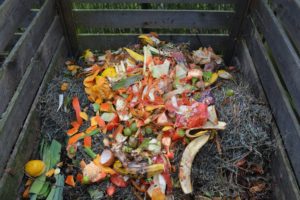All sustainable gardeners should have a compost pile because of its many advantages to the  environment and improved garden success. Compost can act as a soil conditioner, fertilizer, and a natural pesticide, and it can also help the environment by keeping food waste out of landfills.
environment and improved garden success. Compost can act as a soil conditioner, fertilizer, and a natural pesticide, and it can also help the environment by keeping food waste out of landfills.
Making your own soil by composting is a green way for gardeners to take pride in the act of gardening, taking old food scraps and turning them into rich, organic soil for your plants. It saves money over time, it gives back to the environment, improves water quality and reduces the need for fertilizers with chemicals in them.
If composting sounds like something you would like to start doing, follow these steps to start your compost pile, eliminate food waste and contribute to a healthier environment.
- Choose a Location for your Compost Pile

Compost piles should be far removed from your living space as well as any neighbors’ property. It should have partial shade and air flow to keep the compost from overheating in the summer but should be under some sun to keep it from getting too cold in the winter.
- Select a Compost Bin
There are a variety of compost bins to choose from and you can either buy one or make your own. The type of bin will depend on the method of composting you use: holding units, turning units, heaps, soil incorporation or worm composting.
- Add your Materials
 Your compost pile should be a 50:50 mix of nitrogen and carbon rich waste. In other words, nitrogen waste is all your green scraps like grass clippings, weeds and teabags and carbon waste is your brown materials such as cardboard, paper bags, newspaper and prunings. It’s important that it’s an equal mix because if there are too many green scraps your compost will smell, and if there are too many brown scraps it will take too long. Materials to never add are raw meat, fish, citrus, diseased plants, cooked food, dairy, pet feces or cat litter.
Your compost pile should be a 50:50 mix of nitrogen and carbon rich waste. In other words, nitrogen waste is all your green scraps like grass clippings, weeds and teabags and carbon waste is your brown materials such as cardboard, paper bags, newspaper and prunings. It’s important that it’s an equal mix because if there are too many green scraps your compost will smell, and if there are too many brown scraps it will take too long. Materials to never add are raw meat, fish, citrus, diseased plants, cooked food, dairy, pet feces or cat litter.
- Aerate your Heap by Turning It
This step can speed up your compost process by mixing older and newer scraps together. Use a garden fork or compost aerator to turn it regularly so that the pile can breathe and work its magic.
- Finished Product
Your compost pile is finished when it looks like soil, feels crumbly and smells more earthy. It can take anywhere from a few months to a couple years for this to happen, depending on the size of your compost pile, if it has enough moisture, how often you turn it and how much heat it gets.
Find & compare the world’s best garden suppliers for vegetable seeds or flower seeds to use in your garden. Garden Savvy is the gardening catalog of catalogs. Search our gardening database now!
Recent Posts
- Smart Gardening: How Technology Is Revolutionizing Horticulture
- Understanding Gardening Zones: What You Need to Know
- The Right Tools For Your Gardening And Landscaping Needs
- Maximizing Your Harvest: Square Foot Gardening Chart for Beginners
- Holiday Garden Scents: Plants for Natural Aromatherapy in Your Home






